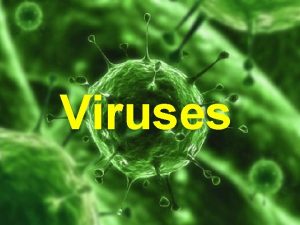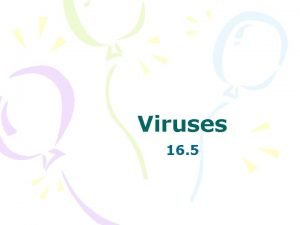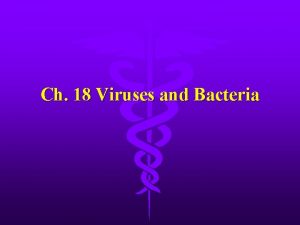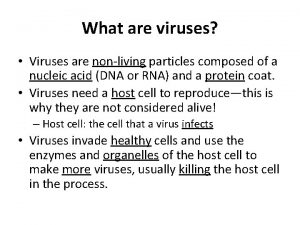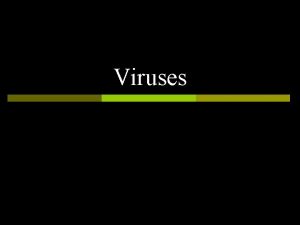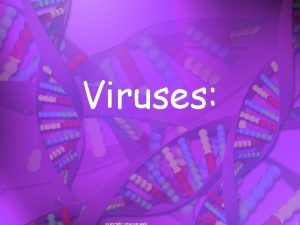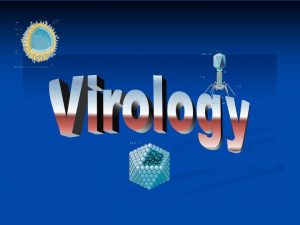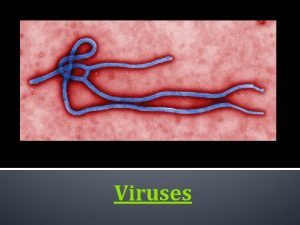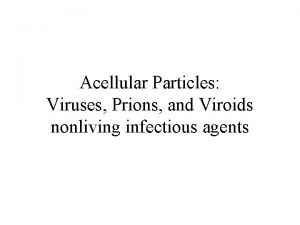VIRUSES Viruses are nonliving particles that can only











- Slides: 11

VIRUSES Viruses are nonliving particles that can only reproduce within a HOST CELL (living cell). -Can NOT carry out life-sustaining functions.

Viral Structure: Nucleic Acid – DNA or RNA encodes for the synthesis of proteins Capsid – protein coat surrounding nucleic acid; arrangement determines shape protects the nucleic acid from digestive enzymes contains special sites on its protein surface that allow the virus to attach and penetrate the host cell membrane Envelope – membrane surrounding capsid; NOT found in all viruses

Viral Replication – Capsid proteins on virus must match proteins on host cell. Lytic cycle: virus attaches to host cell and injects viral DNA uses host cell to create new viruses assemble – destroying host Lysogenic cycle: virus attaches to host cell and injects viral DNA integrates with host DNA creates provirus is replicated along with host cell’s DNA virus may become active, resuming lytic cycle, destroying host


The Lytic Cycle

The Lysogenic Cycle

Diseases and Treatment VIRAL DISEASES Mumps Rabies Influenza Herpes Smallpox Chickenpox Measles AIDS Polio Hepatitis TREATMENT: • Antiviral drugs – treat symptoms; your immune system has to kill virus • Vaccine – preparation of weakened or killed virus/viral particle • stimulates immune system to prevent infection by “teaching” it to recognize virus

Extras Oncogenic viruses – cause cancer; genes disrupt cell cycle Retrovirus – contains RNA; produces a DNA copy of the viral RNA and inserts viral DNA into host cell Prion – protein particle with no nucleic acid; accumulation of proteins in an area kills cells Viroid - small naked single-stranded RNA molecules that cause plant diseases

HIV is a retrovirus injecting the enzyme, reverse transcriptase into the cell to copy viral RNA into DNA.

Viruses are host specific – a protein on the surface of the virus has a shape that matches a molecule in the plasma membrane of its host, allowing the virus to lock onto the host cell.

HIV doesn’t target just any cell, it goes right for the cells that want to kill it. “Helper" T cells are HIV's primary target. These cells help direct the immune system's response to various pathogens. After many years of a constant battle, the body has insufficient numbers of T-Cells to mount an immune response against infections. At the point when the body is unable to fight off infections, a person is said to have the disease AIDS. It is not the virus or the disease that ultimately kills a person; it is the inability to fight off something as minor as the common cold.
 Insidan region jh
Insidan region jh Why are viruses considered nonliving?
Why are viruses considered nonliving? Lytic infection
Lytic infection M7rh5si5154 -site:youtube.com
M7rh5si5154 -site:youtube.com Watch?v=dhlvcdeg0yg
Watch?v=dhlvcdeg0yg Thơ thất ngôn tứ tuyệt đường luật
Thơ thất ngôn tứ tuyệt đường luật Tôn thất thuyết là ai
Tôn thất thuyết là ai Phân độ lown ngoại tâm thu
Phân độ lown ngoại tâm thu Chiến lược kinh doanh quốc tế của walmart
Chiến lược kinh doanh quốc tế của walmart Gây tê cơ vuông thắt lưng
Gây tê cơ vuông thắt lưng Block nhĩ thất độ 2 mobitz 1
Block nhĩ thất độ 2 mobitz 1 Tìm vết của mặt phẳng
Tìm vết của mặt phẳng

